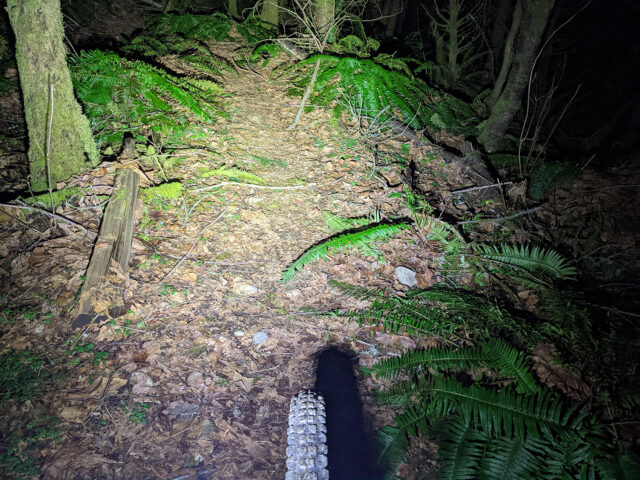I’m fortunate in that this job gives me ample opportunity to ride during daylight hours mid-week, even in the winter when they’re at a premium. But that means a lot of solo rides while other folks are at work, and so I’ve also been getting back into the swing of going for night rides so that I can get out with friends, and with that, I’m re-remembering how much fun they can be.
For one thing, riding in the dark is a great way to change up trails that you’ve ridden a million times and know like the back of your hand. The woods look and feel different at night, and there’s a lot to be said for the quiet stillness you feel having the place to yourself, and being in the little bubble of light you’re producing for yourself. It’s a special experience.
That said, folks who haven’t ridden with really good, modern lights would probably be surprised at just how much light they put out, and how well you can see with them, too. The experience is definitely still different than riding in the daytime — in large part because of the tunnel vision effect you get from only having the path in front of you lit up — but you can definitely ride tricky trails at pace with the right light setup.
And I’ve got some tips on that front. If you’re just dipping your toe in and don’t want to spring for multiple lights right off the bat, I’d definitely recommend starting with a bright one on your helmet. Having the light point where you’re looking (as opposed to where your bar is pointing) is often helpful for all the reasons that you’d expect.
But if you really want to get serious about night riding, a second bar-mounted light is a really good call. For one thing, it leaves you with a backup in case something goes wrong. But having a light that’s not on your head also helps see the trail a lot more clearly. With just a helmet light, your line of sight is almost in line with the light source, and the problem that creates is that you can’t see the shadows your light is casting from roots, rocks, and the like. Everything you see is directly lit with little contrast, and even though it’s bright, it makes trail texture harder to process.
That’s where the bar light comes in. Since you’re looking well over the beam of light, you see both the lit-up obstacle itself, and a bit of the shadow that it casts. That extra contrast goes a long way towards seeing what you’re doing. And so my preferred setup is a really bright bar light with a big battery that will last through the whole ride and a smaller helmet-mounted light that I’ll just turn on for the descents. Since I don’t need a lot of runtime out of my helmet-mounted light, it can be fairly small and light (though I still prefer a corded battery that I can put in a hip pack, to get that weight off my head).
This season I’ve been using the Magicshine Montero 5000 (review coming soon) as my bar light, paired with a Light and Motion Seca 2500 (with the smaller 3-cell battery) on my helmet, and it’s a great combo. I’ve also used a Seca 2500 (bar) and Seca 2000 (helmet) pairing extensively, and while it’s definitely not as bright as the Montero 5000, it’s plenty for my needs. If you’re looking for a setup to start out, I’d recommend aiming for something at least in the 1500-2000 lumen output range as a baseline.
So get yourself a light and get out there. And as always, let us know how it goes in the comments.



In my experience, most battery-powered lights for bikes barely last a season. After multiple purchases over the years I’ve given up. And all such lights stop working at inconvenient times when the batteries run out. For anyone serious about night riding, get yourself a dynamo hub system. You’ll never look back. Expensive one time cost, yes, because you have to rebuild your wheel with the new hub. The weight penalty is trivial and the friction penalty non existent with modern dynamos. The build quality is great and the lights for systems (e.g. SON Edulux) are superb and truly waterproof. We’ll worth it.
I think you are buying the wrong lights Eric, in my group we ride every week at night, my Gemini lights are coming up to 4th year and work perfectly, buddies using Exposure lights are getting 5 yrs plus.
Agree re night riding being awesome, there are trails in my town i have never ridden during the day, only at night, and once familiar with them speed is a not a problem as you are very focused on the lit terrain directly in front of you.
If you havent tried, get out there. However good lights are essential, spend as you would on a helmet as they are a safety device and cheap is false economy.